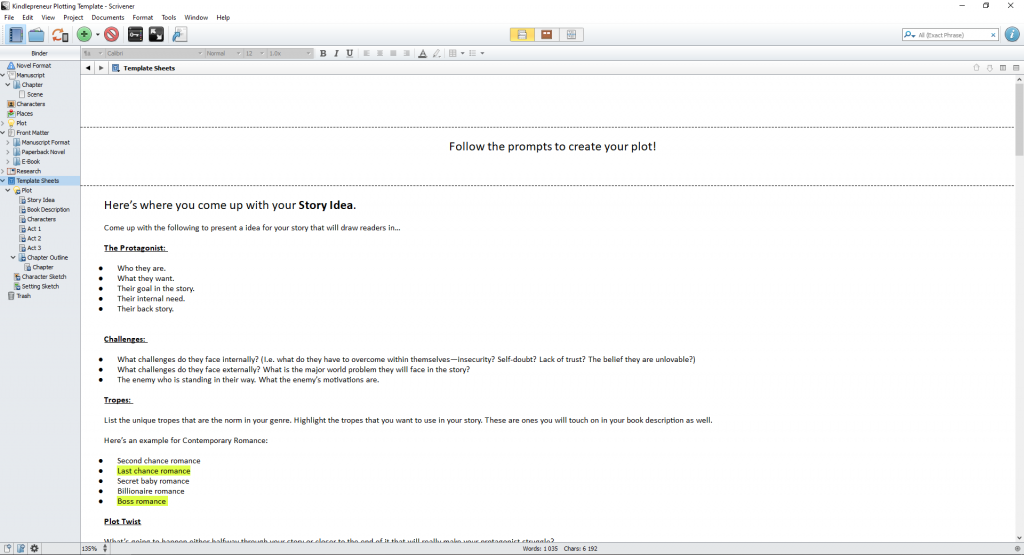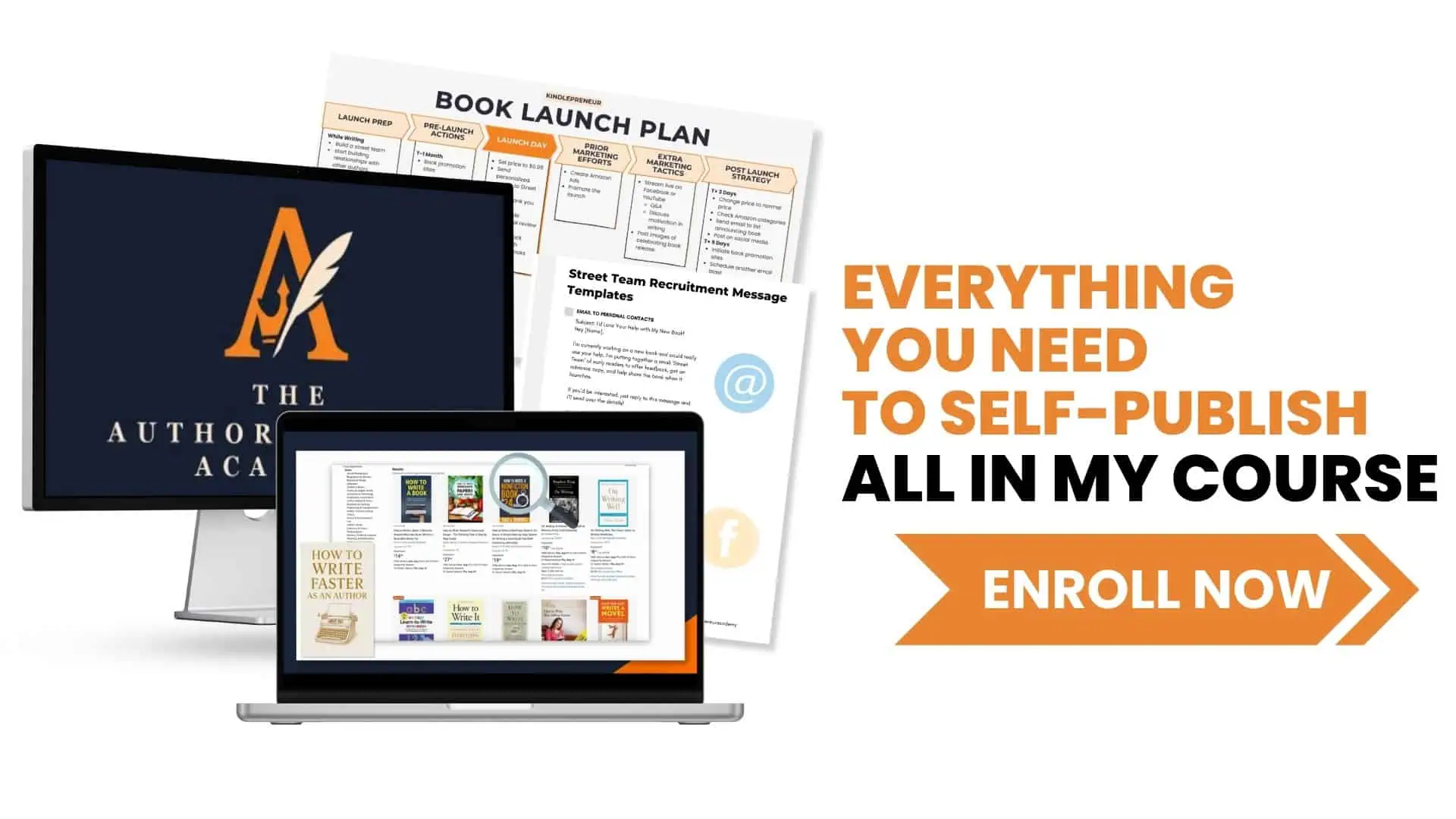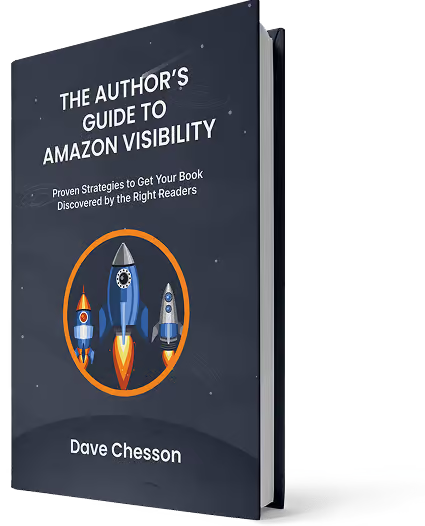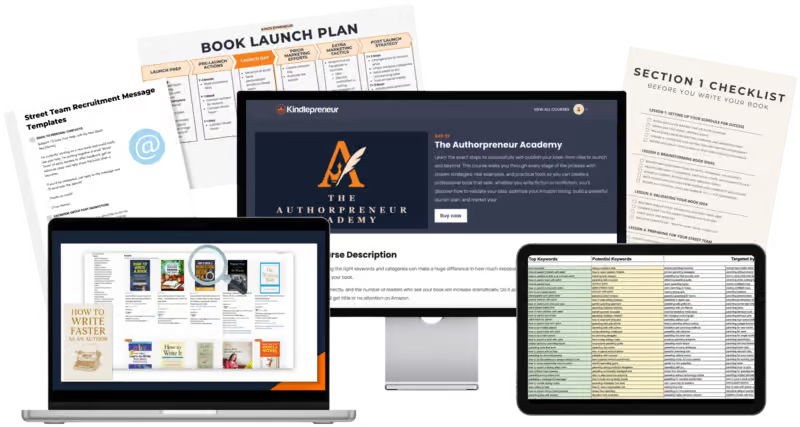Writing a book, fiction or nonfiction, isn’t easy, and planning what you want to write before you start can help you write faster and get books to market sooner. That’s why we personally tested four of the best pieces of story outline software on the market—tools and apps that can help you outline your books and even write them.
In this review, we'll be breaking down each of the products according to who they're best suited for—with an overview of their features and prices.
And we’ll be deciding which story software is the best for different types of writers, whether they’re fiction writers or non-fiction writers.
In this article, you will find our picks for:
- The best outline software overalls
- The best outline software for nonfiction authors
- Other great options you might want to check out
Just so you know–there will be affiliate links in this article. It helps me keep the coffee fund topped up, but it doesn't detract from the quality of the software we're about to discuss. What you're going to get is an unbiased view of the different software and who they're best suited to. So… let's check them out!
| The Novel Factory | Scrivener | Plot Factory | Plottr | |
|---|---|---|---|---|
| Between $7.50-$60.00 Monthly | Once-off $49 | Between $9.00-$19.00 Monthly | Starting at $60 Annual or $199 Lifetime | |
| No (30 day free trial) | No (30 day free trial) | Yes | No (30 day free trial) | |
Download | Yes | Yes | No | Yes |
| Yes | Yes | Yes | Yes | |
| Yes | Yes | N/A | Yes | |
| Yes (with online version) | Yes | N/A | Yes | |
| Yes | Yes | Yes | Yes | |
| Yes | Through 3rd Parties | Yes | Yes | |
| Yes | No | Yes | Yes (limited) | |
| Yes | No | Yes | Yes | |
#1. My Favorite Outline Software: Plottr

Plottr is a versatile software that allows you to visually plan your books. It's simple and easy to use, and it cuts out the trouble of a steep learning curve that's so often present when it comes to working with new applications. Here's a summary of what it has to offer:
- Downloadable software that's always available, online or offline
- Highly customizable plotting
- Ease of use
- An amazing character creation tool
- Plot templates
- Character templates
- Drag and drop features for organizing plots and subplots
- Notes
- Different timeline and outline views
- Tag and character filtering
- Multiple views
- Customizable series pages
- Syncs with online version through Plottr Pro
Plottr's no-frills approach makes it a great application for authors looking to up their productivity, which is one of the reasons why it's my favorite.
Not only is it simple and easy to navigate, it also does just about everything you would need, especially when writing fiction.

Plottr Summary
Let's take a look at the pros and cons of Plottr and figure out if it's the right tool for you.
Plottr Pros
- Easy to use–a guided tour
- Highly customizable
- Character and plot templates
- Lifetime pricing available
Plottr Cons
- No space for writing the actual draft
- World-building and tagging could be better
Pricing: 30-Day Free Trial// Windows and Mac Version–$60-$270 per year // Lifetime Version–$199
Want more information? Click here to read our full review of Plottr.
#2. My Second Favorite: Plot Factory

This software is great for all fiction writers. This doesn't mean it trumps all the others. Just that it is a software that any author of fiction or nonfiction could use without missing out on too many features.
And while I wouldn't necessarily rank it above Plottr, it still has a lot of great features, and might work better for some writers.
Plot Factory is exactly what you think it is… a great place for you to craft your plots. It's an online software–subscription-based–that allows authors to create outlines from templates, create universes and characters, track their word count goals, and more. If you're looking for a piece of software that's not focused on one specific thing, but is a great all-rounder when it comes to planning a book, Plot Factory is the right software for you.
Here's what's on offer:
- Outlining with set templates
- An online experience that's smooth and streamlined
- Distraction-free plotting
- Plotting with your own templates or free-form
- Character creation templates
- Universe creation templates
- A name generator
- Word count tracking and statistics
- Story sharing and narration
- Story creation
Plot Factory is super easy to use for authors who are both fiction and nonfiction, and the plotting features are pretty cool. You can create multiple stories, export them, and use plot templates or create your own.

Plot Factory Summary
To figure out how versatile Plot Factory is for authors, and whether it's a good all-round solution for both fiction and nonfiction writers, let's take a look at where its strong and where its weak.
Plot Factory Pros
- Amazing plot templates to use
- Easy to upload your own template or free-form plot
- Good character creation system
- Affordable
Plot Factory Cons
- No downloadable software
- Not as good when it comes to world-building
- Not as guided as some other writing tools
Pricing: Basic–FREE// Hobbyist per month/year–$9/$90 // Enthusiast per month/year–$14/$140 // Novelist per month/year–$19/$190
SPECIAL DISCOUNT FOR KINDLEPRENEUR READERS… You can grab your subscription to Plot Factory now, and get 35% off for 12 months using the following discount code: kpnr-35
All you have to do is enter the coupon code on checkout.
Want more information? Click here to read our full review of Plot Factory.
#3. The Novel Factory

Fiction authors need outlining software that either guides them through the plotting process or allows them to create plots on their own unhindered. While most of the outlining software on this list does exactly that, The Novel Factory is unique in that it has a serious compilation of guiding articles and videos to help authors plot.
The Novel Factory offers authors:
- A guided plotting roadmap to help authors plot their novels
- Plotting templates that are tailored toward specific genres or beats
- The ability to upload outlining templates if you have one you already use
- Freeform outlining utility–you can outline as you see fit in the software online
- Character creation
- World and object creation
- An entire section to write all the drafts of your novel
- Daily word count tracking statistics
- Submissions tracker (if you're going the traditional route)
- A light and dark mode to minimize strain on your eyes
In short, this software provides everything a budding (or experienced) fiction author might need to create their novel from start to finish, including useful tips on publishing traditionally and independently. It comes in both an online subscription and a desktop download format.
Here's an example of what it's like to outline with the Novel Factory…

The Novel Factory Summary
As you can see, it's easy to edit, change, move around, and create your outline using The Novel Factory. But surely, it can't all be good, right? No software is made perfect, so… what are the pros and cons of using The Novel Factory for outlining your work?
The Novel Factory Pros:
- Provides a guided plan for authors to follow if they don't know how to plot
- Plotting is fully customizable (drag, drop, create, use a template or don't)
- You can write your entire story in the app and export it–your work is never held hostage by the app
The Novel Factory Cons:
- Costlier than some of the other software on this list
- The cost of the online app is directly related to how much storage you use
- You have to have an internet connection to use the online software
- The desktop software doesn't work on Macs
With all of this taken into consideration, it's no wonder this is the best software around for fiction authors. But how much does it cost?
Pricing: Basic Monthly–$7.50 // Standard Monthly–$20.00 // Premium Monthly–$60.00 with a discounted rate if you choose the yearly option.
Even better… The Novel Factory has offered a 20% discount to all Kindlepreneur customers. Simply use the coupon: KINDLEPRENEUR at check out to redeem your 20% off. (That means 20% off the monthly or yearly subscription!)
Want more information? Click here to read our full review of The Novel Factory.
#4. Best Nonfiction Outline: Scrivener

Scrivener isn't just an outlining software… it's a way of life. But seriously, it's an amazing desktop application that helps authors organize their documents in one place. It's great for fiction and nonfiction authors, but we've chosen it for nonfiction outlining because of the ease of use with which an author can create an outline template.
Scrivener allows authors to:
- Populate a template that’s already laid out for you
- Create an entirely new template for your book and outline
- Add or delete files and folders
- Create your own character sketches or place sketches
- Upload other author templates
- Create collections of your work
- Sync your work to your mobile
- Write your entire book
- Format it for publishing
- View your story in three different modes
- Split the screen as you write so you can work on one screen while viewing the other
- Organize your work with a corkboard
Scrivener is incredibly versatile and that's precisely why it works for outlining nonfiction… and for writing it. In fact, I'd say you could use it for fiction too, as long as you have the right template available. Authors can fully customize their templates as they outline:

Scrivener Plotting Feature Summary
Scrivener is an incredibly versatile tool–it's no wonder it's so popular with independent authors. But can it be successfully used for plotting your work? And what are the pros and cons of doing so?
Scrivener Plotting Feature Pros
- Fully customizable
- Authors have complete control over how they plot or what they write
- All documents and files are available on their computer at all times
- A once-off purchase!
Scrivener Plotting Feature Cons
- No plotting guidance provided for new authors
- Steep learning curve when it comes to understanding how to use the software
Pricing: Windows Standard License–$49 // Mac Standard License–$49 // iOS Standard License–$19.99 // Mac and Windows License–$80
Want more information? Click here to read our full review of plotting inside Scrivener.
Put Plotting Into Practice
If you are ready to jump into any of these tools and want to make sure you are plotting right, I recommend watching this mini masterclass by Jenna Moreci.
Jenna Moreci is a #1 bestselling author of dark fantasy, as well as a YouTube sensation with hundreds of thousands of subscribers. View more videos here.
Did We Miss Any Amazing Outlining Software?
These are the best story outline software applications we could find… But did we miss any in our search? Be sure to mention your favorites and your experiences on our contact page.








Dave, I’m confused. Why is there a yearly price and a lifetime price per year? Wouldn’t the lifetime price be a one-time fee because it’s for life?
Whoops…great catch. Fixed. It’s just $99 for life.
Great recap, Dave, thanks. I use Scrivener and Plottr, and am still trying to figure out how to make Plottr easier to use than just doing it in Scriv. My only comment is that I bristle at the generalized “Scrivener has a steep learning curve” idea. It has an easy-medium learning curve for the basics–anyone can get started writing and using the index cards and such right off the bat. It’s using the full capabilities of the program that is very steep. I even took a class on formatting and compiling and it’s still difficult–no wonder I jumped to Vellum as soon as I heard about it! But overall, just to write and edit, Scrivener isn’t hard.
True…but if you were to compare the ease of Vellum as to the ease of Scrivener, I’d say one is very easy to use, and the other…not so much. I think Scrivener made way too many things too difficult to do and so they get a mark for it. It’s got a lot of capabilities, but most of those extra parts are not very intuitive.
1. Scrivener also has a name generator (as you mentioned it as a plus on other software).
2. The Snowflake method is now in Plottr, I believe.
I’m one of those who loves my iPad and a BT keyboard, so accessing Scrivener is great. And like a previous commenter, I find Weiland’s outlining software good but the ‘he’ issue is driving me mad. My protagonist is definitely a ‘she’.
Ah and yes…very good point.
I have written three books with the software package yWriter from Spacejock Software by Simon Haynes. I absolutely favor the clean software, user interface, and very extensive plotting and information handling features.
It is a highly worthy alternative to Scrivener, is absolutely free, and Simon is personally responsive to any queries and questions.
The software is invisible between my creative writing and my manuscripts. It works flawlessly with taking dictation from Nuance’s Dragon 15.3.
You should check it out.
I use Plottr and love it. I write a lot of details on my scene cards, so that when I switch from Timeline with all the great graphics to Outline, I end up with a detailed scene-by-scene outline to export to Word. This software works very well for non-fiction, too.
Nice!
Thanks for giving us a look at the different options for plotting, etc. I’m a die-hard panster, have always thought that heavy outlining and plotting would stifle creativity. The flip side of panster-writing is, I frequently write myself into a hole and spend forever digging my way out. ????
So, I recently tried Plottr on my MAC and I’m loving the simple user interface. You definitely nailed the pros! Although I have to say that I disagree with one of the Plottr Cons listed: No space for writing the actual draft. This is a plotting/planning software, not a word processing program.
Writing software (I use Word) lets us set most of the formatting parameters ahead of time, such as Drop Caps, margins, different styles, headings, insert scene break images, etc. I wouldn’t want to bog down the planning process with all of that.
Thanks again for for showing us some viable software options.
Haha…I know what you mean. As for the con, true… BUT when I was testing the others, many of the others allow for such. Therefore, in a ‘relative’ manner, this was a con. However, I also see that they are working to integrate with Scrivener, which would be awesome. Thanks to my article, it caught the attention of their team and I’ll be meeting with them next week to discuss improvements and such…yah!
Hi Dave
Thanks for this (as always).
Have you heard of Subtext? It’s a more user-friendly ‘version’ of Dramatica Pro (which, while excellent, can be tough to comprehend for emerging writers)
Cheers and thanks for your informative emails.
No I haven’t but I’ll have to check that out.
Writeitnow5 is supposed to be good. Made by the same company that makes Jutoh.
That is a good thing and a bad thing then…haha. Jutoh, amazing capability…but poor user experience (UX) and user interface (UI). However, I’ll give that a try. Thanks for the suggestion.
I still love Scrivener for everything! And there are plenty of fiction templates people have created (just search “novel templates for scrivener”) if you need some sort of plot/outline format to get going. That said, if The Novel Factory created software for mac’s, I might have to take a look! (Yes, bite me! I love my mac!!)
Hey, I hear you on both fronts. I’m a Scrivener guy and I even have my own Template that I designed 🙂 As for Novel Factory, yup. I actually used to work for Apple so I’m a Mac guy as well.
What are your thoughts about Dabble?
I’ve had a couple of people ask about Dabble. I’ll look into it and update my article on that so as to include it.
Dave,
Thanks a bunch! Thorough, thoughtful, truthful, and as always professional. Great stuff!
Enough for a lazy panster to head over to Plottr. My gut leads me to being a panster, but
my head pushes Plottr. The reason being it’s cheap … no seriously, it seems to tick all the
boxes a non-techie octogenarian, would be writer of childrens adventure novels, could
possibly cope with.
THat’s my overall feel too. Visually its ‘comprehensive’ and very beneficial. Plus for me, I am a Scrivener pro, and this feels like the scrivener components of outlining but on steroids. Furthermore, I love that it isn’t a subscription base.
I use Dabble – it’s available on laptop and phone and syncs across all your devices. Easy to use, well laid out. Have a look.
Will do. I’ve seen a couple of people bring that up.
As always, you’ve got great information! I’ve got two software tools that you haven’t mentioned, though, both of which are linked to existing fiction outlining methods.
1. Snowflake Pro is based on Randy Ingermansson’s Snowflake Method.
2. Outlining Your Novel is essentially a digital version of a workbook for KM Weiland’s brilliant Outlining Your Novel book.
Authors these days are really spoiled for choice! 🙂
Katie Weiland is a genius – I will have to look into that. I love her website and her information so I’m sure that is amazing. As for Snowflake Pro, I’ll look into that too. I know that a couple of the Outline Softwares have a Snowflake template in them.
Totally agree about Kate Weiland. She is a true mentor for me, as are you.
I’ve just brought OYN software. It’s nice because it has directions. I don’t have much time, so I don’t know it well, but it looks promising. Weiland admits it has a clumsy print option. It’s rich on character and worldbuilding part and has a good template on basic story structure.
The Snowflake method I know,but I haven’t tried the software. I guess it’s for the authors who know some story structure already.
I’ll have to try that.
I have tried the OYN software and although the concept is AMAZING, the interface and options are very clumsy and limited. (It may be a little thing, but having the main character always labeled as “he” drives me bonkers.) I really like Weiland’s books and methods, but wish the software was better. I started using Novel Factory recently and have found it really helped me plot out a book that had me stumped for a year.
Huh…didn’t know than on OYN – I can understand that.
Thank you, Dave. Your hammer always hits the nail. Best wishes, your Fan, Daniel.
Thank you Daniel. That made my morning to read.
Interestingly, I started using Scrivener for fiction. Coming from a training background, I’ve always outlined my training and nonfiction writing using Word (or a word processor). While working on a nonfiction project, I was having a difficult time remembering if/where I had used specific examples. I didn’t want to use the same ones too many times, and finding and tracking each example in Word was a PITA. So I broke up the Word document and put the content into Scrivener, which I think does a great job separating chapters and lets you jump around when necessary. I was amazed at how much easier the process became. I now use it for a lot of other things also, not necessarily manuscript driven.
And while there are minimal plots installed, you can find several online (including some through NaNo).
Thanks for the comparisons. You’ve piqued my interest and I will look at a couple of them. I also didn’t realize there was an iOS version of Scriv, but I seldom write on the iPhone.
Yeah, it saved my life when I was writing my master thesis when I was at Naval Post-graduate School. As for iOS, I know what you mean. I didn’t think that was a big deal but apparently there are a lot of authors who us the iOS version. Using an ipad and a wireless keyboard is their jam.
Have you heard of Campfire Technology? It’s an outlining/plotting tool. I don’t know much about it. Saw it in a NaNoWriMo email.
No, I haven’t. But I’ll check it out.